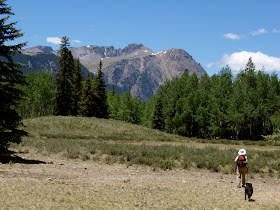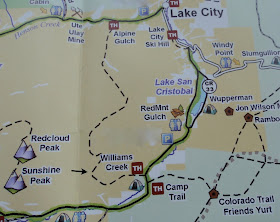With its red and green chilies and blue, blue skies Albuquerque is a primary color wonderland.
 |
Dried red chilies adorn the entrance of an
Albuquerque eatery. |
My day in New Mexico’s largest city began at the Gold Street Caffe where I ordered The Cowboy breakfast—scrambled eggs, smoked ham, and mascarpone cheese on a green-chili-cheese biscuit, accompanied by fresh salsa. The meal tasted as good as it sounds, and the coffee was smooth and satisfying too.
After breakfast I visited San Felipe Church, the oldest church in New Mexico and the anchor of the revived historic district “Old Town”. The adobe structure with its stark white crosses jutting into the indigo sky proved irresistibly photogenic.
From the church I walked to the Rattlesnake Museum at the other end of the square. The museum owner must be a Steve Irwin fan; a video of the famed crocodile hunter played continuously while I was there. Dozens of live rattlesnakes filled the museum, living out their lives in small terrariums. Maybe it’s better than being hunted down, tortured, and killed for fun—as people do to rattlers.
I left the museum and noticed a wedding party assembled on the lawn in Old Town square. The bridesmaids wore brilliant red dresses and the groomsmen’s black tuxes were adorned with red carnations, bowties and cummerbunds. After the ceremony the group posed in front of San Felipe. I can’t say I remember their faces but their red, white and black attire against the backdrop of the sandstone church and bright blue sky comprised a stunning portrait.
 |
| San Felipe Church—a splendid backdrop for any occasion. |
Leaving Old Town I drove uptown to the University of New Mexico and visited the University Art Museum, featuring black and white seascape photography by Japanese photographer Hiroshi Sugimoto.
If you are interested in learning more about this artist, viewing his works or being apprised of upcoming exhibitions please visit the Hiroshi Sugimoto page at Artsy.net. Artsy is dedicated to promoting arts education and to making the world's art accessible to anyone and I'm pleased to provide a link to their site.
A short drive from the University took me to Nob Hill, another restored district directly east of campus. Just like Old Town the area is filled with shops. Old Town, Nob Hill and the University are located along Historic Route 66, made famous by the 1946 Nat King Cole song, and then made obsolete in New Mexico by Interstate 40. Historic Route 66 has seen better days. I’m sure it’s also seen worse days, and now Albuquerque is trying to revive some of those better days again. Most of the old motels—for better or for worse—still survive.
****
Next on today’s agenda—an early dinner. Driving north on 4th street, the neighborhoods changed from used car lots to pawn and payday loan shops, then to antique stores and feed stores, and finally to upscale therapeutic healing boutiques. It was in this neighborhood that I found Casa de Benavidez. I took a seat on the outdoor patio under a giant cottonwood tree and ordered the house specialty “our very famous sopapilla burger”. It’s a hamburger with green chili, beans, lettuce and tomato in a sopapilla bun. One bite of the juicy burger and I knew I had come to the right place.
 |
Satisfy your southwest dinner cravings with
Casa de Benavidez's "very famous sopapilla burger". |
The Sandia Peak Tramway was my after-dinner destination. I arrived at The Tramway and watched the cars sliding along the 2.7 mile cable, up and down the steep mountainside. “Do I really want to do this?” I asked myself. “Yes, I think you should.” I answered. So I bought a $20.00 ticket and waited for one of the cars to slide down the mountain. The cars ascend 3,800 vertical feet to the mountain top at 10,300’ in elevation. The ride is thrilling—at one point the cable car is suspended 1000 feet over the canyon below. Thankfully the cars are fully enclosed, but the tramway operator unnerved a few passengers by saying he’d slow the car down to go over the part of the cable that was duct-taped. Very funny.
 |
The black arrow points to our car's shadow on
the rocks below. The docking station is at the
top of the photo. You can see how some riders
may have been nervous. |
 |
A Sandia Peak cable car approaches the docking station,
successfully navigating the 2.7 miles of cable—the
longest aerial tram ride in the world. |
Temperature at the bottom of the cable car ride: 75º. At the top: 48º. I donned my jacket when we disembarked. From the top of Sandia Peak the view stretched for 100 miles. A paraglider prepared to shove off from the mountain top and as I boarded a car to descend he pushed off from the rocky cliff. All things considered I think I’d rather ride the cable car to the bottom. Our car operator informed us that only the most experienced paragliders are permitted to ride the tramway and take off from the mountain’s edge; the tram company has a list with the names of these authorized adventurers.
But there are tamer ways to explore the wonders of Albuquerque. Linger here, then return home with your own colorful memories from this vibrant city.
 |
Paragliding into the sunset above Albuquerque. An "expert" takes off
from Sandia peak. |
Make plans to visit Albuquerque by visiting this website: http://www.itsatrip.org/

























